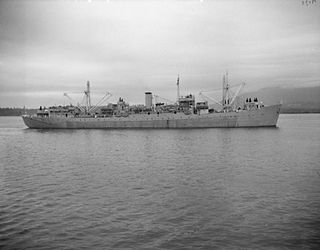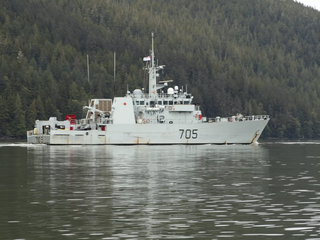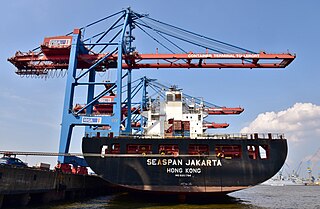
The Royal Canadian Navy is the naval force of Canada. The navy is one of three environmental commands within the Canadian Armed Forces. As of February 2024, the RCN operates 12 Halifax-class frigates, 12 Kingston-class coastal defence vessels, 4 Victoria-class submarines, 4 Harry DeWolf-class offshore patrol vessels, 8 Orca-class patrol vessels, and several auxiliary vessels. The RCN consists of 8,400 Regular Force and 4,100 Primary Reserve sailors, supported by 3,800 civilians. Vice-Admiral Angus Topshee is the commander of the Royal Canadian Navy and chief of the Naval Staff.

The Orca-class patrol vessels are a class of eight steel-hulled training and surveillance vessels in service with the Royal Canadian Navy (RCN) at Patrol Craft Training Unit (PCTU) Canadian Forces Base (CFB) Esquimalt. Based on the Australian Pacific-class patrol boat design, all of the Orca vessels were constructed by Victoria Shipyards between November 2004 and November 2008. In addition to carrying the RCN designation of patrol craft training (PCT), the Orca class are not formally commissioned in the RCN and as such do not possess the His Majesty's Canadian Ship (HMCS) prefix.

HMCS Regina is a Halifax-class frigate that has served in the Canadian Forces and Royal Canadian Navy since 1993. Regina is the fifth vessel in her class which is the name for the Canadian Patrol Frigate Project. She is the second vessel to carry the designation HMCS Regina. She is assigned to Maritime Forces Pacific (MARPAC) and is homeported at CFB Esquimalt.

HMCS Cape Breton was a Royal Canadian Navy Cape-class maintenance ship. Originally built for the Royal Navy as HMS Flamborough Head in 1944, she was transferred in 1952. Upon her commissioning she was the second ship to bear the name Cape Breton. She served operationally from 1953–1964, when she was laid up. She was used as a floating machine shop until the late-1990s, before being sold for use as an artificial reef off the coast of British Columbia.

Canadian Forces Base Esquimalt is Canada's Pacific Coast naval base and home port to Maritime Forces Pacific and Joint Task Force Pacific Headquarters. As of 2018, 4,411 military personnel and 2,762 civilians work at CFB Esquimalt.

HMCS Algonquin was an Iroquois-class destroyer that served in the Royal Canadian Navy (RCN) from 1973 to 2015.

HMCS Huron was an Iroquois-class destroyer that served with the Canadian Forces from 16 December 1972 to 23 October 2000. She served mainly on the western coast of Canada. After decommissioning, her hull was stripped to be used in a live-fire exercise. The ship's hulk was eventually sunk by gunfire from her sister ship, HMCS Algonquin. Huron was the second ship of her class and the second vessel to use the designation HMCS Huron.

HMCS Brandon is a Kingston-class coastal defence vessel that has served in the Canadian Forces since 1999. Brandon is the eleventh ship of her class. She is the second vessel to use the name HMCS Brandon. The Brandon is assigned to Maritime Forces Pacific (MARPAC) and is homeported at CFB Esquimalt.

HMCS Edmonton is a Kingston-class coastal defence vessel that has served in the Canadian Forces since 1997. Edmonton is the fourth ship of its class, all of which were built for the Maritime Coastal Defence Vessel Project. The ship is the first vessel to use the designation HMCS Edmonton. The ship is assigned to Maritime Forces Pacific (MARPAC) and is homeported at CFB Esquimalt.

HMCS Whitehorse is a Kingston-class coastal defence vessel that has served in the Canadian Forces since 1998. Whitehorse is the sixth ship of her class. The first vessel named for the city in the Yukon, the ship is assigned to Maritime Forces Pacific (MARPAC) and is homeported at CFB Esquimalt.

HMCS Yellowknife is a Kingston-class coastal defence vessel that has served in the Canadian Forces since 1998. Yellowknife is the seventh ship of her class. She is the first vessel to use the designation Yellowknife in the Royal Canadian Navy. The coastal defence vessel is assigned to Maritime Forces Pacific (MARPAC) and is homeported at CFB Esquimalt.

Seaspan ULC provides marine-related services to the Pacific Northwest. Within the Group are three (3) shipyards, an intermodal ferry and car float business, along with a tug and barge transportation company that serves both domestic and international markets. Seaspan, is part of the Washington Companies that are owned by Dennis Washington. Kyle Washington, is the Executive Chairman of Seaspan, who has become a Canadian citizen.

Victoria Harbour is a harbour, seaport, and seaplane airport in the Canadian city of Victoria, British Columbia. It serves as a cruise ship and ferry destination for tourists and visitors to the city and Vancouver Island. It is both a port of entry and an airport of entry for general aviation. Historically it was a shipbuilding and commercial fishing centre. While the Inner Harbour is fully within the City of Victoria, separating the city's downtown on its east side from the Victoria West neighbourhood, the Upper Harbour serves as the boundary between the City of Victoria and the district municipality of Esquimalt. The inner reaches are also bordered by the district of Saanich and the town of View Royal. Victoria is a federal "public harbour" as defined by Transport Canada. Several port facilities in the harbour are overseen and developed by the Greater Victoria Harbour Authority, however the harbour master's position is with Transport Canada.

HMCS Esquimalt was a Bangor-class minesweeper that served in the Royal Canadian Navy during the Second World War. She saw service in the Battle of the Atlantic and in the Battle of the St. Lawrence. She was sunk in 1945, the last Canadian warship to suffer that fate. She was named for Esquimalt, British Columbia.
CFAV Tillicum is a harbour tug of the King's Harbour Master. She is stationed at CFB Esquimalt, on Vancouver Island.

The Glen-class tug is a class of naval tugboat operated by the Royal Canadian Navy. Constructed in Canada, the class entered service between 1975 and 1977. The five vessels that comprise the class are split between the two major naval bases of the Royal Canadian Navy. The Royal Canadian Navy operated a fleet of tugboats during the Second World War which were also named the Glen class. The vessels of the current Glen class are each named after one of the vessels of the earlier class.

CFAV Glendale is a Glen-class naval tugboat operated by the Royal Canadian Navy. Built at Yarrow Shipyard, Esquimalt, British Columbia and launched in 1975, the ship was delivered on 16 September 1975. Attached to Maritime Forces Pacific, the ship is based at CFB Esquimalt.

HMCS Beacon Hill was a River-class frigate that served in the Royal Canadian Navy (RCN) as an ocean convoy escort during the Second World War. She fought primarily in the Battle of the Atlantic. In 1954 she was converted to a Prestonian-class frigate and served until 1957. She was named for Victoria, British Columbia, but because HMS Victorious was in service with the Royal Navy, the RCN, in an effort to avoid confusion, chose to honour the city by choosing another name associated with it.

HMCS Nanaimo was a Flower-class corvette that served with the Royal Canadian Navy during the Second World War. She served on both coasts during the war. She was named for Nanaimo, British Columbia.
















